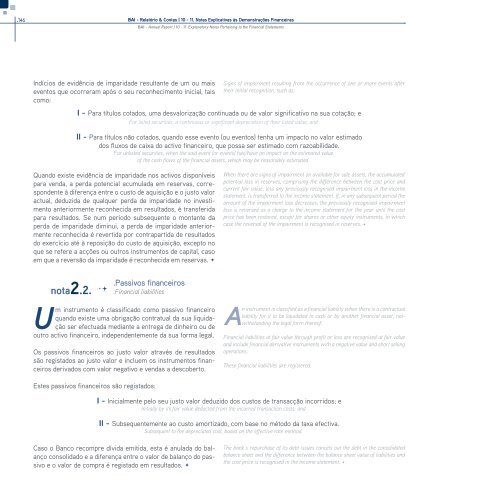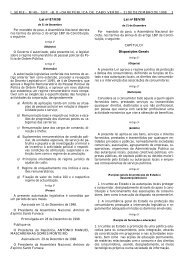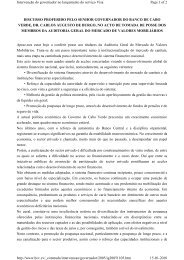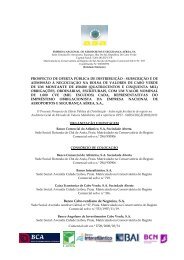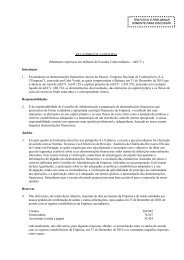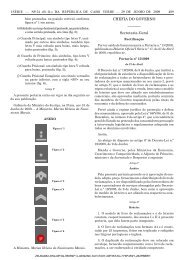Relatorio_final_BAI_10. - Cabo Verde
Relatorio_final_BAI_10. - Cabo Verde
Relatorio_final_BAI_10. - Cabo Verde
You also want an ePaper? Increase the reach of your titles
YUMPU automatically turns print PDFs into web optimized ePapers that Google loves.
.146<br />
<strong>BAI</strong> - Relatório & Contas | 10 - 11. Notas Explicativas às Demonstrações Financeiras<br />
<strong>BAI</strong> - Annual Report | 10 - 11. Explanatory Notes Pertaining to the Financial Statements<br />
Indícios de evidência de imparidade resultante de um ou mais<br />
eventos que ocorreram após o seu reconhecimento inicial, tais<br />
como:<br />
nota2.2.<br />
Um instrumento é classificado como passivo financeiro<br />
quando existe uma obrigação contratual da sua liquidação<br />
ser efectuada mediante a entrega de dinheiro ou de<br />
outro activo financeiro, independentemente da sua forma legal.<br />
Os passivos financeiros ao justo valor através de resultados<br />
são registados ao justo valor e incluem os instrumentos financeiros<br />
derivados com valor negativo e vendas a descoberto.<br />
Estes passivos financeiros são registados:<br />
Signs of impairment resulting from the occurrence of one or more events after<br />
their initial recognition, such as:<br />
I - Para títulos cotados, uma desvalorização continuada ou de valor significativo na sua cotação; e<br />
For listed securities, a continuous or significant depreciation of their listed value; and<br />
II - Para títulos não cotados, quando esse evento (ou eventos) tenha um impacto no valor estimado<br />
dos fluxos de caixa do activo financeiro, que possa ser estimado com razoabilidade.<br />
For unlisted securities, when the said event (or events) has/have an impact on the estimated value<br />
of the cash flows of the financial assets, which may be reasonably estimated.<br />
Quando existe evidência de imparidade nos activos disponíveis<br />
para venda, a perda potencial acumulada em reservas, correspondente<br />
à diferença entre o custo de aquisição e o justo valor<br />
actual, deduzida de qualquer perda de imparidade no investimento<br />
anteriormente reconhecida em resultados, é transferida<br />
para resultados. Se num período subsequente o montante da<br />
perda de imparidade diminui, a perda de imparidade anteriormente<br />
reconhecida é revertida por contrapartida de resultados<br />
do exercício até à reposição do custo de aquisição, excepto no<br />
que se refere a acções ou outros instrumentos de capital, caso<br />
em que a reversão da imparidade é reconhecida em reservas.<br />
.Passivos financeiros<br />
.Financial liabilities<br />
When there are signs of impairment on available for sale assets, the accumulated<br />
potential loss in reserves, comprising the difference between the cost price and<br />
current fair value, less any previously recognised impairment loss in the income<br />
statement, is transferred to the income statement. If, in any subsequent period the<br />
amount of the impairment loss decreases, the previously recognised impairment<br />
loss is reversed as a charge to the income statement for the year until the cost<br />
price has been restored, except for shares or other equity instruments, in which<br />
case the reversal of the impairment is recognised in reserves.<br />
An instrument is classified as a financial liability when there is a contractual<br />
liability for it to be liquidated in cash or by another financial asset, notwithstanding<br />
the legal form thereof.<br />
Financial liabilities at fair value through profit or loss are recognised at fair value<br />
and include financial derivative instruments with a negative value and short selling<br />
operations.<br />
These financial liabilities are registered:<br />
I - Inicialmente pelo seu justo valor deduzido dos custos de transacção incorridos; e<br />
Initially by its fair value deducted from the incurred transaction costs; and<br />
II - Subsequentemente ao custo amortizado, com base no método da taxa efectiva.<br />
Subsequent to the depreciated cost, based on the effective rate method.<br />
Caso o Banco recompre dívida emitida, esta é anulada do balanço<br />
consolidado e a diferença entre o valor de balanço do passivo<br />
e o valor de compra é registado em resultados.<br />
The bank’s repurchase of its debt issues cancels out the debt in the consolidated<br />
balance sheet and the difference between the balance sheet value of liabilities and<br />
the cost price is recognised in the income statement.<br />
nota2.3.<br />
Os Instrumentos financeiros derivados são registados<br />
ao justo valor, na data em que o Banco negoceia os<br />
contratos e são subsequentemente reavaliados ao justo<br />
valor. O justo valor é obtido através de preços de mercados cotados<br />
em mercados activos, incluindo transacções de mercado<br />
recentes, e modelos de avaliação, nomeadamente: modelos de<br />
fluxos de caixa descontados.<br />
Os derivados são considerados como activos no balanço, quando<br />
o seu justo valor é positivo e como passivos quando o seu<br />
justo valor é negativo, e com ganhos e perdas reconhecidos em<br />
resultados do exercício.<br />
Certos derivados embutidos em outros instrumentos financeiros,<br />
como seja a indexação da rendibilidade de instrumentos<br />
de dívida ao valor das acções ou índices de acções, são bifurcados<br />
e tratados como derivados separados, quando o seu risco<br />
e características económicas não sejam íntima e claramente<br />
relacionadas com os do contrato hospedeiro e este não for<br />
mensurado ao justo valor com variações reconhecidas em resultados.<br />
Estes derivados embutidos são mensurados ao justo<br />
valor, com as variações subsequentes reconhecidas na demonstração<br />
dos resultados.<br />
Os derivados são também registados em contas extra-patrimoniais<br />
pelo seu valor teórico (valor nocional).<br />
<strong>BAI</strong> - Relatório & Contas | 10 - 11. Notas Explicativas às Demonstrações Financeiras<br />
<strong>BAI</strong> - Annual Report | 10 - 11. Explanatory Notes Pertaining to the Financial Statements<br />
.Instrumentos financeiros derivados<br />
.Financial derivative instruments<br />
Financial derivatives instruments are recognised at fair value, on the date<br />
on which the bank negotiates the contracts and are subsequently revalued<br />
at fair value. The fair value is obtained from market prices in active<br />
markets, including recent market transactions and assessment models, namely<br />
discounted cash flow models.<br />
Derivatives are classified as assets in the balance sheet, when they have a positive<br />
fair value and as liabilities when their fair value is negative, with gains and losses<br />
thereon being recognised in the income statement for the year.<br />
Certain derivatives embedded in other financial instruments, such as the indexing<br />
of returns on debt instruments to share values or indices, are separated out and<br />
processed as separate derivatives, when their risk and economic characteristics<br />
are closely and clearly related with those of the main agreement and this is not<br />
measured at fair value whose changes are recognised in the income statement.<br />
Such embedded derivatives are measured at fair value, and their subsequent<br />
changes recognised in the income statement.<br />
Derivatives are also recognised in off-balance sheet accounts at their notional<br />
value.<br />
147.


